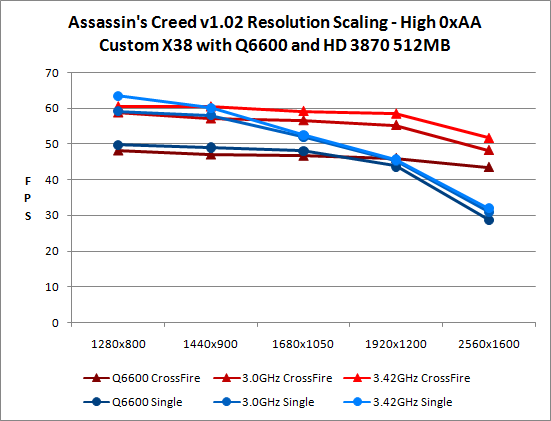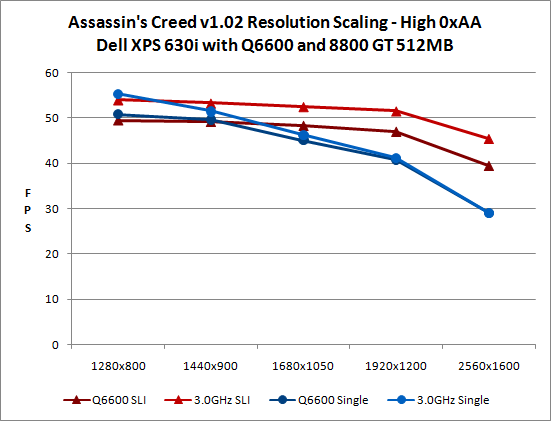CPU Performance Scaling
It would actually be quite interesting to take a closer look at how processors affect performance in AC. Specifically, I would have liked to test AMD Phenom as well as Core 2 Duo; this article is already long for a "game review", however, so I decided to stick with overclocking to see how it affects performance. The ATI and NVIDIA results are in separate graphs to help keep things legible. Since we couldn't enable anti-aliasing above 1680x1050, all testing was done at maximum detail with anti-aliasing disabled. We are also only reporting results for AC version 1.02, since the only area where 1.0 is faster is in anti-aliasing on ATI hardware.


If you're looking to get performance above 60 FPS, it's obvious that the first step is going to be purchasing the fastest CPU you can find. AC definitely supports dual-core processors, and even quad-core may be beneficial in certain situations. However, quad-core CPU usage often stays below 50% of the total CPU potential. Thus, an overclocked dual-core processor appears to be the best choice for maximizing AC performance.
During initial testing, we were a bit surprised to find that SLI didn't seem to improve performance. As this is a "The Way It's Meant to Be Played" game, that would have been another serious blow to NVIDIA's credibility. At the time, we were testing with a stock-clocked Q6600 at 1680x1050 and various graphics settings in order to utilize anti-aliasing. It was only when we began overclocking that we discovered the real culprit was CPU performance. There's CPU overhead associated with CrossFire and SLI, so with slower CPUs at moderate resolutions SLI and CrossFire will actually reduce performance in AC.
With an appropriately fast CPU -- at least 3.0 GHz would be our recommendation -- and running at 2560x1600, SLI and CrossFire are able to show substantial performance benefits. SLI and CrossFire both improve performance by 56%, but we still appear to be at least somewhat CPU limited. Increasing the CPU clock speed to 3.42 GHz on the X38 system (the maximum stable result for this particular system) further improves CrossFire scaling to 62%.
We should also take a moment to point out that in testing CrossFire did not work with both graphics chips until the latest catalyst 8.5 drivers. (That necessitated retesting all of our results, unfortunately, which is one more reason you're only reading this review now.) We heard a rumor that renaming the executable to COJ_DX10.exe (i.e. using the Call of Juarez CrossFire profile) would enable multi-GPU support; what we actually discovered was that renaming the executable did improve performance, but it improved it with single graphics cards as well. Whatever optimizations were taking place did not depend on CrossFire, and those optimizations now exist in an AC specific profile.
Finally, we need to caution against using the above results to compare ATI and NVIDIA graphics performance. The Dell system is running with DDR2-667 memory at 5-5-5-15 timings while the X38 system has DDR2-800 at 4-4-4-12 timings. The combination of BIOS tuning and memory performance could account for much of the performance differential. ATI looks to have a slight edge, but it's definitely not enough to make them a clear winner -- unless you're running 1680x1050 or lower with 4xAA.










32 Comments
View All Comments
Griswold - Monday, June 2, 2008 - link
Thats no excuse. Halo sucked performance and gameplay wise compared to the PC-first titles of then - and that is what matters. In essence, the game is bad when you're used to play that genre on the PC. Same is true for gears of war but that port is lackluster in many more ways.I fell two times for console to PC ports. Never again.
bill3 - Monday, June 2, 2008 - link
The even worst shooter is Resistance on PS3.